#it's kinda tragic he's literally an evil demon but I feel some strange attachment to him
Photo

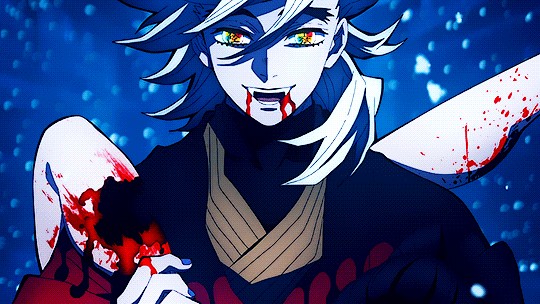

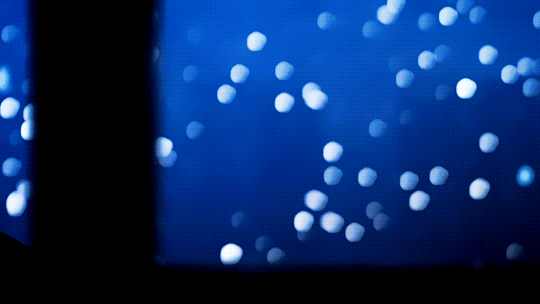
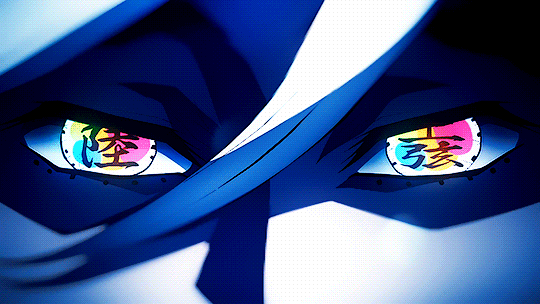
Hey, what’s the matter? You poor things. I happen to be kind-hearted, so I can’t look the other way. That girl is probably going to die any minute now. I’ll give you some blood! Both of you! If he chooses you, you can become demons. Life is a sacred thing. You should treasure it. Now then... Can you become demons... A Twelve Kizuki like me... And rise up to the Upper Ranks, I wonder.
#knyedit#knysource#dailyanimatedgifs#dailyanime#anisource#kimetsu no yaiba#kny#demon slayer#kny s2#douma#doma#sky gifs#Loml 💖#i can't believe I finally get to post this I'm shaking a little bit <3#I think it looks okay I actually am happy with it <3#I just love douma so much <333 thank you all so much for your cute messages#happy douma day!!!!#he means everything to me#people know how much I struggle with things but he is one character who brings me so much happiness I just adore him#it's kinda tragic he's literally an evil demon but I feel some strange attachment to him#I hope you like these!!!! I hope they don't fail#thank you thank you anyone that said you thought of me or sent me something or just anything!!!#I've waited years for this day <3 I'm literally so happy#ily douma <333
2K notes
·
View notes
Text
Hyakkimaru as an incarnation of Fudo, the Buddha’s fearsome face?
It's interesting how both Taho and Hyakki have their good reasons to do bad things that it’s almost impossible to give a clear answer who is on the right and who is on the wrong here. They descend the road to hell almost in sync, both of them getting more and more resolved to fight for their respective goals and protect their respective important things despite the costs. It was explicitly shown in Jukai episode, scenes jumping between them mercilessly slaying ghouls and throwing away their moral (Hyakki saying screw the people, he has Dororo; Taho saying how he will never let his feelings get in the way again), and then again and again, episode 21 being an epitome of their resolve to literally jump into the abyss. And here's the climax: we have them both as demons.
Or not both?
The ravine full of corpses and those not-completely-demonic orange flames, which transformed the horse into a fire-breathing kirin, had an interesting detail: the giant Buddha statue carved on the side of it. It holds a straight two-sided sword in the right hand and overall resembles the statue of Fudo from episode 13. The statue in the ravine:

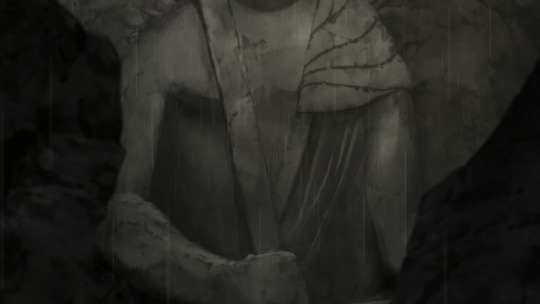
And now the statue from the episode 13:

It’s face isn’t fierce like that of the Fudo from ep13, but it is most likely Fudo too.
Fudo Myo-o is one of the important deities of Japanese Buddhism. His statue can be seen in so many places in Japan that it’s not uncommon to find one near a waterfall or simply by a mountain path.
His Sanskrit name is Ācala and in Japanese his name is written 不動明王. It literally means “The immovable wisdom king”. He is the guardian of Buddhism and one of the five Wisdom kings along with Gōzanze, Gundari, Daiitoku and Kongōyasha. As such, he is the central figure and when the Five Wisdom Kings are represented together, he usually is in the middle.
He converts anger into compassion and cuts the ties of negative feelings and demons to liberate us from suffering through self-control.
Fudō has a furious countenance, blue skin, wielding a straight, double-edged sword in his right hand and rope or noose in the left. The rope is used to pull people back on to the correct path when they are heading towards evil or binds those that are ruled by violent emotions and passions. If the rope is ineffective then the sword is used to sever the link between worldly afflictions and karma thereby quenching the defiance in a persons heart to return them to the right path.
The image of the sword and dragon is seen to represent the weapons used by Fudō, the dragon being the rope, used to capture and bind, not to kill. You can seen here the rule in Gyokko ryū to use only the force that is necessary to achieve victory. The sword is the last resort and you must not rush to use it. Use the technique or weapon that is appropriate.

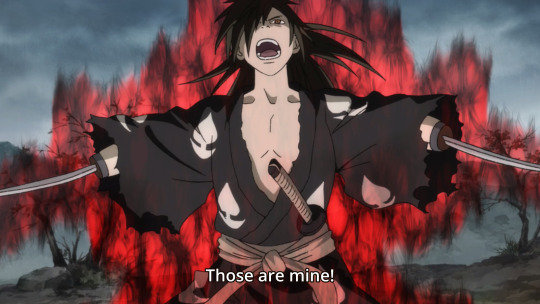
While some details are questionable, like wisdom or converting anger into compassion, the parallels are obviously intentional: the red flame surrounding him; the “dragon” as a fire-breathing horse. The parallels between Hyakkimaru and Fudo start the 2nd cour of the anime, the carver finding him to be an ideal personification of the fearsome Buddha: “I must have his face! The most magnificent I’ve ever seen! I’ve been waiting for a face like yours forever!” It appeared kinda strange back then, like why? This pure cute boy - an ideal face for Fudo?? But now it makes sense.
Which rises the question: if Hyakki, “reborn” at the bottom of the ravine full of corpses that were trashed there to rot, is representing the fearsome Buddha, is it completely justifiable for him to destroy and kill Daigo people who were thriving upon his sacrifice? Is he acting as a divine force here, a sword of karma, bringing justice to the land? To a certain extent, sure he is. But the real question is: doest it give him an exclusive right to kill, and by “right” here I mean an action free from karmic consequences? An indulgence is a western motif, but does it work here? I believe it doesn’t and I would hate it the most if the creators justify his rampage in the end, revealing that he actually wasn’t a demon, like Dororo is afraid, but a Buddha’s fierce face - Fudo.
What I mean is, being the one who brings the karma to the land, Hyakki still remains a human being whose actions must have the consequences, too. He isn’t a wise detached god free from destructive passions who acts with a sole purpose “to return human hearts to the right path.” If anything, he is a destructive passion himself. “He converts anger into compassion and cuts the ties of negative feelings and demons to liberate us from suffering through self-control” - and this is exactly what Hyakki isn’t, even if his actions have the effect of “cutting the ties of demons” for the Daigo land. So, this is ambiguous: yes, his motives are righteous, and yes, his actions serve as a payback to all those Daigo people (who have no idea, but ok, we can call their prosperous life undeserved), but at the same time - no, his actions AREN’T GOOD. They are driven by the same sentiments that Hyakki accuses his family for: desire to have a normal life. Desire to protect what’s important to you. Remember Sabame telling to Hyakki:
“If it is our destiny to live on on this land, I must protect the land and it’s people. I didn’t care that they were ghouls. I was ready to give up my soul if it meant my people could escape this hell. Let me ask you one thing: why do you kill ghouls?” And Hyakki never answers that question. “I don’t care what you’re trying to protect. I will kill the demons and get it all back.” “A vagabond like you would never understand,” Sabame says. But ever since Dororo was captured by Itachi, Hyakki begins to understand that he, too, has something to protect. The transformation of his motivations completes in ep.20 after he nearly loses Dororo, not being able to defend her, and his resolve takes the form of this destructive perseverance to get back his hands and eyes as tools for it no matter the costs. And now he’s going on a bloody rampage to protect Dororo and get her back. It is a tragic irony that in the end he comes to where his enemies started. The power of human attachments...
And isn’t it exactly the same goal for Taho? Basically, it is the same: to protect, only Taho’s motives are more external (not specific people whom he holds dear, but Daigo people in general), while Hyakki’s are internal (Dororo as an important person in his life).
What makes it even more ambiguous is the fact that we see Taho from Hyakki’s perspective still having no sparks of the demonic flame: he is white EXCEPT for Hyakki’s own eyes on him, which is hella strange if Taho is an incarnation of Asura.

I can take the red eyes and the red spots where the arms are joined to Hyogo and Mutsu’s bodies as just a depiction of the demon’s doing, or that while Hyakki’s body parts are possessed by Asura, they are kind of demonic as well; but the fact that Taho has no demon flame in his aura still remains. I doubt the creators simply forgot to add it here, they are always thorough with the details. It can mean various things and I won’t even dive into it since it’s no use. The mechanics of this world, though has it’s inner logic, still can be bent whatever side the creators want it in the end, so no more predictions. Soon we’ll see. But it was fun to notice and decipher all the curious details.
_
Let me add another description of Fudo I found:
The aim of the warrior is to posses Fudōshin, the spirit of Fudō. Fudōshin can be understood as many things – having a magnanimous and compassionate heart that remains dauntless – to possess unwavering resoluteness – to be a point of calm in a tempest – to be steadfast, immovable, imperturbable. By carrying an image of kenmakiryū on ones weapons the warrior is invoking the protection of Fudō and expressing the aspiration to achieve Fudōshin. Fudō serves humankind in protecting it from itself, the same should be true of the martial artist in protecting others.
The martial artist is not expressing the idea of non-violence. The martial artist will fight when required for the purpose of protecting others. The difference between selfish power and just action. The martial artist does not seek violence but will respond appropriately to the violence of others with a calm heart.
This can be seen as the calming of emotional responses or extremes. Fudōshin is to be able to control emotions, removing the ego enabling the body, mind and spirit to act in unison, unencumbered by desires – as seen in the idea of mushin 無心, no-mind, a mind that is not distracted as opposed to an empty or vacant mind.
Well, Hyakki is nowhere near that state yet.
And another curious parallel:
There is a legend that Fudō was challenged to duel with a representative of another faith. They both transformed their bodies into various forms to gain advantage, upon assuming the form of flaming swords they found they were equally matched. Fudō then transformed into a dragon, entwining the opponents sword and began to devour it from the tip and achieved victory. This image has been passed down to the modern day as the sword entwining dragon Kurikara Ryū-Ō Fudō 倶梨伽羅龍王不動 or shortened to Kurikara Fudō 倶梨伽羅不動. The dragon is both servant of Fudō as well as being a representation the deity.
The ambivalence continues: Tahomaru, Hyogo and Mutsu as a personification of Asura
27 notes
·
View notes
Text
Warning: Rant
So... I was thinking about Fairy Tail, as I am wont to do, and something occurred to me. Before I get started, I would just like to clarify a few things. I love Fairy Tail (even if there’s a lot I don’t like). I love Jellal. I love Ultear. I love the Tartaros arc.
I am going to complain about all of those things. This will not be short. This will not lack profanity. Read at your own risk.
So one of the most controversial characters in Fairy Tail - aside from all the other ones - is Jellal Fernandes. Some people love him, some people hate him, some people are indifferent, etc. Sadly, most of the people who love him have a tendency to defend him blindly (yours truly included). So let’s talk about some problems people have with him.
The biggest is his recruitment of the Oración Seis - five individuals who were at one point enslaved to him, whom he beats the shit out of and recruits. A lot of people feel that he didn’t give them a choice. For a while, I scoffed at that, remembering that Jellal flat-out told them that he wasn’t taking them back to jail, and I never saw any implications that he was going to kill them should they refuse. But then I looked at things through their eyes, and realized that they probably didn’t feel the same way. They saw a guy who was powerful enough to have destroyed them by himself and who admitted to being sent by the person most likely to want them locked up again. In their eyes, they probably didn’t have as many options. The anime expanded the scene further, showing their decision to follow him and officially become “good”, but it didn’t happen in the manga, so it’s really up to the viewer whether to count it as canon (to the best of my knowledge, it isn’t official, but I don’t know what Mashima-sensei thinks about it).
Another problem people have with Jellal is everything being blamed on Ultear, which... honestly? Yeah, that bothers me too. Because it’s not about Jellal or Ultear - it’s about taking the blame from Zeref so that he can be a tragic villain (something that is very hard for me to accept at this point). First, we’re told that Jellal is being possessed by Zeref, who is - as far as we knew then - this mysterious evil wizard who was responsible for a lot of shit but was thankfully now dead. Okay, that works. But then it’s revealed to have been Ultear all along (in the manga, this is revealed almost immediately, complete with a bubble bath scene, but it takes longer in the anime). The problem here is that that makes no goddamn sense. It feels like an asspull, even in the manga, as if Mashima-sensei had finally developed Zeref enough to genuinely get attached to him as a character (which writers do), only to decide that Zeref should be sympathetic.
First off, since when can Ultear brainwash people? Her magics are Arc of Time and Ice-Make. She uses the brainwashing thing once, and never again after that, despite the fact that it would’ve been really fucking useful.
Second, if Jellal wasn’t being possessed, where the hell did he get all that magical power? It’s not implied that he’s always just had a bunch of magic - he doesn’t use it until after going off the deep end. If he was possessed by a super powerful evil wizard, then yeah, it makes sense that he’d have a lot of power, but Ultear wasn’t supplying him. So, where’d it come from? And regardless of who was controlling him, why the hell did they allow him to let Erza get away?
Third, how the hell is he still alive? In the manga, it was stated that he was atomized by the destruction of the Tower. Atomized. As in, reduced to atoms. But come Oración Seis arc, and he’s... totally fine. Well, he does have memory loss, leading to:
Four, what’s up with his brain? He can’t remember anything except Erza’s first name and, somehow, the location of Nirvana. Oh, and he remembers how to use his magic. Somehow. Putting aside that that’s not how memory loss works, that’s still a lot of disbelief we’ve gotta suspend. For that matter, how the hell did Brain find him? What, he was just in the right place at the right time? Really?
Five, wasn’t Brain the one who taught him magic? And wasn’t Brain also the one responsible for Ultear’s life being a dumpster fire? In that case, why the fuck would she work with him? For the sake of the Alliance, which was apparently a non-aggression pact (that is also bullshit, but it’s irrelevant for the moment)? Doubtful.
Lastly, why was Ultear even in the Tower at all? Did Hades send her? Why? Did he genuinely believe that a little girl would skip through a Tower of terrified slaves and people being tortured (you know, like she was), and not think to herself “gee, this is kinda messed up. Maybe I shouldn’t be working for this guy.”? Did he actually think that? And even if he did, wasn’t Hades supposed to be extremely smart? He shouldn’t have even taken the risk.
So yeah, there are a lot of plot holes. It’s a shounen, so that’s to be expected, but here’s what really gets me: All of this, everything you’ve read so far, could easily have been avoided. How, you ask? Well, this is where the Tartaros arc comes into the equation.
Jellal is insanely strong, can apparently survive getting atomized, doesn’t seem to fully understand other people’s point of view on things, and has a strange obsession with Zeref (who, by the way, has done nothing to any of the members of Crime Sorcìere. Nothing). Sound familiar?
Yeah, the Etherious demons. Literally all of the above problems can be solved by making Jellal a demon. You still feel like someone should’ve been controlling his actions during his streak of villainy? FINE. Seilah exists. Problem solved. If she can use Macro on herself, she can use it on other demons. Mirajane’s immunity can be explained due to the variety of her abilities. Easy.
So, how does this work? Let’s say that Jellal is the result of an attempt to create a humanoid demon that can act as a spy or something. Only he doesn’t understand why he should be looking down on humans. So Mard Geer decides to “help” him think that all humans are shit by sending him to the Tower and sealing his powers, hoping that he’ll develop some sort of deep-seated loathing of humanity. Only instead he makes friends and decides to try and liberate them. Obviously, since the Tower is under Grimoire Heart’s control, this isn’t good for the Alliance, so Seilah heads over to make sure Jellal is unsuccessful. She decides to allow Erza to get away in order to use her as a scapegoat and keep everyone in line.
Flash-forward to Jellal getting blown up in the Tower. He’s destroyed, and reforms in the Cube. Like Tempester, he doesn’t have his memories. Part of the Balam Alliance involves the three major guilds to try to do at least one Nice Bad Guy Thing™ per year, so Tartaros gets Crawford Seam to implant some knowledge about Nirvana into Jellal’s head and they hand him over to Brain (he can still be in a coma if you wanna see him in chains so badly). Jellal wakes up, has no idea what the hap is fuckening, and does what he does in canon (only without remembering Erza - he just figures that the people not trying to take over the world are probably the good guys). Anyway, he helps Natsu fight Zero, gets arrested, and leaves to be probably executed.
Only his memories start returning, and he realizes “oh shit, Tartaros is full of demons, I’m one of them, the humans are fucked”. So he basically decides to try and help the humans by providing them with what little he remembers. Ultear and Merudy break him out, and Crime Sorcìere becomes a kinda task force (as in, the Council is pretending to be actively hunting them, but isn’t because 1. they’re really good at taking out Dark Guilds, and 2. Jellal keeps sending them extremely helpful info).
Hell, this even fixes the beach scene. Jellal has the majority of his memories back, knows he’s a demon, and feels like he needs to tell Erza, because he’s not sure if he’s capable of loving her (literally). But he panics, says the “I have a fiancée” line, and doesn’t end up telling her. The scene where Ultear and Merudy tease him about his shitty lying is replaced with them scolding him and saying that of course he can love and Erza doesn’t care what he is.
Anyway, Jellal’s struggle changes from him trying to forgive himself for crimes the series is intent on reminding us “weren’t his fault” (yet also fails to explain exactly why they weren’t his fault) to him trying to come to terms with his identity as a demon.
This also gives him a reason to go after Zeref. The Etherious, with the exception of Mard Geer, are hardwired to believe that they need to reunite with Zeref. Jellal wants to prove - to himself and everyone else - that he’s more than his origins and decides to kill Zeref (ironically becoming one of the only demons doing what he was supposed to be doing in the process), despite knowing that he will die if Zeref does.
Now, let’s get back to the Jellal vs. the Oración Seis fight. Jellal is a character who wants to be a good person, but shouldn’t he understand that the Seis might not see things the way he does? Well, no, actually. Most demons don’t seem to have any empathy at all - even Natsu has difficulty seeing things from other people’s point of view.
Speaking of Natsu, Jellal’s whole “kill Zeref” plan becomes a bit of a problem once he realizes that Natsu is also a demon, and will thus also die if Zeref does. Jellal has, over the course of the series, demonstrated little to no regard for his own well being, but it’s doubtful that he’d be okay with Natsu dying.
One other complaint people have is that Jellal is often thrown into the plot when there’s no reason for him to be there. But if he’s a demon, his presence can become foreshadowing for Natsu’s identity. Instead of having his character randomly show up to have a moment with Erza, the series could instead show what he was doing compared to what Natsu was doing, highlighting their similarities. And then, once Natsu learns the truth, Jellal can be the one who says “yeah, well, welcome to the club”, giving him an actual reason for showing up so much.
And that’s still not everything. This also provides a solution to the rest of the cast learning about the demons in the first place. In canon, Doranbolt finds out from Cobra - who, when you think about it, really shouldn’t have known about that. It’s highly unlikely that the Dark Guilds had meetings (again, the whole “it was a non-aggression pact” thing), and Brain was good enough at shielding his thoughts that Cobra didn’t know his “father’s” true opinion of him until Brain literally back-stabbed him.
Is that it? Nope. Jellal’s relationship with Merudy and Ultear becomes a lot more meaningful too. Instead of being “oh yeah, they’re friends now, yay”, it becomes Jellal accepting them in spite of the crimes they (willingly) committed, and them accepting him in spite of him being a demon. Hence why he knows that Fairy Tail won’t abandon Natsu - because true friends will be there for you, even if you are literally a monster.
On top of all that, there’s Jellal’s strength. Several people have said that he shouldn’t have been able to defeat the Seis, given that Midnight beat him so badly the first time they fought (to be fair, he’d just woken up from a coma and spent a lot of magic on a suicide attempt). But the Etherious are powered by negative emotions like anger and hate (hence why Natsu can solve most of his problems by getting pissed off at them), so Jellal could’ve just been powering up off how much he hates himself and/or Zeref.
To sum it all up, some of the biggest problems with Fairy Tail could’ve been resolved by making Jellal into a demon. And that says a lot about this series, to be perfectly fucking honest.
#fairy tail#ft spoilers#fairy tail rant#ft rant#jellal fernandes#jellal rant#tartaros#tartaros arc#UGH THIS TOOK FOREVER#ek3 complains
112 notes
·
View notes